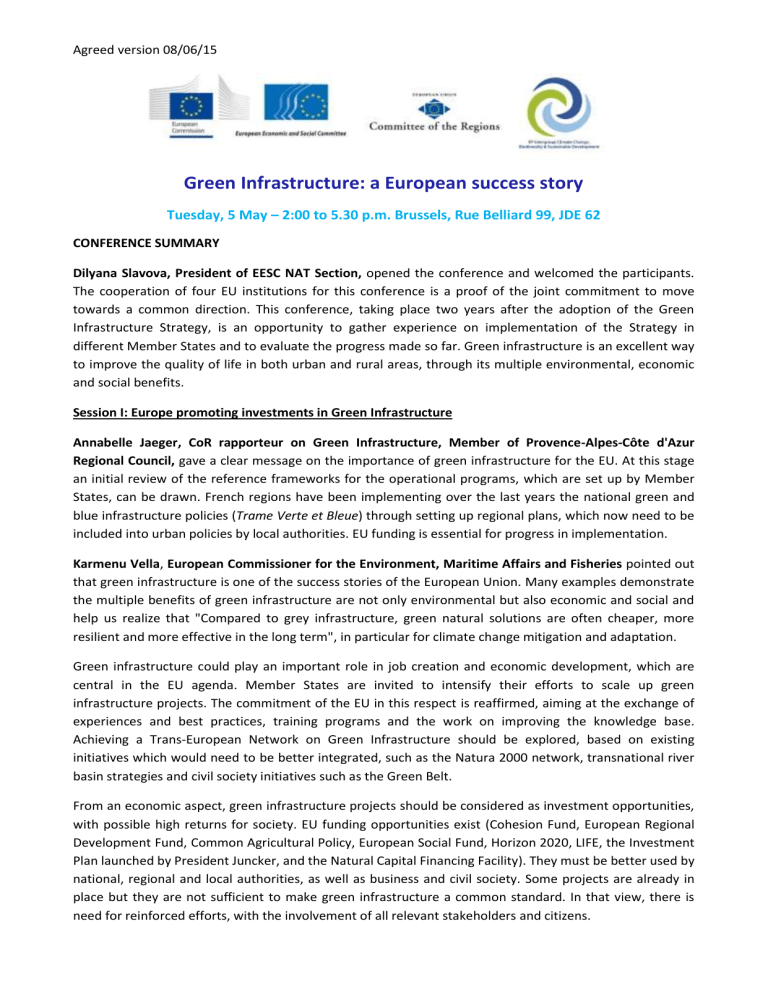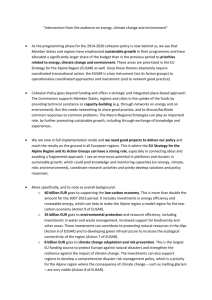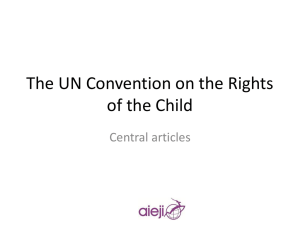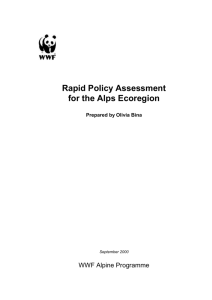Green Infrastructure - EESC European Economic and Social

Agreed version 08/06/15
Green Infrastructure: a European success story
Tuesday, 5 May – 2:00 to 5.30 p.m. Brussels, Rue Belliard 99, JDE 62
CONFERENCE SUMMARY
Dilyana Slavova, President of EESC NAT Section, opened the conference and welcomed the participants.
The cooperation of four EU institutions for this conference is a proof of the joint commitment to move towards a common direction. This conference, taking place two years after the adoption of the Green
Infrastructure Strategy, is an opportunity to gather experience on implementation of the Strategy in different Member States and to evaluate the progress made so far. Green infrastructure is an excellent way to improve the quality of life in both urban and rural areas, through its multiple environmental, economic and social benefits.
Session I: Europe promoting investments in Green Infrastructure
Annabelle Jaeger, CoR rapporteur on Green Infrastructure, Member of Provence-Alpes-Côte d'Azur
Regional Council, gave a clear message on the importance of green infrastructure for the EU. At this stage an initial review of the reference frameworks for the operational programs, which are set up by Member
States, can be drawn. French regions have been implementing over the last years the national green and blue infrastructure policies (Trame Verte et Bleue) through setting up regional plans, which now need to be included into urban policies by local authorities. EU funding is essential for progress in implementation.
Karmenu Vella, European Commissioner for the Environment, Maritime Affairs and Fisheries pointed out that green infrastructure is one of the success stories of the European Union. Many examples demonstrate the multiple benefits of green infrastructure are not only environmental but also economic and social and help us realize that "Compared to grey infrastructure, green natural solutions are often cheaper, more resilient and more effective in the long term", in particular for climate change mitigation and adaptation.
Green infrastructure could play an important role in job creation and economic development, which are central in the EU agenda. Member States are invited to intensify their efforts to scale up green infrastructure projects. The commitment of the EU in this respect is reaffirmed, aiming at the exchange of experiences and best practices, training programs and the work on improving the knowledge base.
Achieving a Trans-European Network on Green Infrastructure should be explored, based on existing initiatives which would need to be better integrated, such as the Natura 2000 network, transnational river basin strategies and civil society initiatives such as the Green Belt.
From an economic aspect, green infrastructure projects should be considered as investment opportunities, with possible high returns for society. EU funding opportunities exist (Cohesion Fund, European Regional
Development Fund, Common Agricultural Policy, European Social Fund, Horizon 2020, LIFE, the Investment
Plan launched by President Juncker, and the Natural Capital Financing Facility). They must be better used by national, regional and local authorities, as well as business and civil society. Some projects are already in place but they are not sufficient to make green infrastructure a common standard. In that view, there is need for reinforced efforts, with the involvement of all relevant stakeholders and citizens.
Agreed version 08/06/15
Angélique Delahaye, MEP, Vice-chair of the EP Intergroup in Climate Change, Biodiversity & Sustainable
Development. There is need to align the different new policies and strategies and to adopt legislation which will ensure that they dovetail. There is a gap between the adopted strategies and their implementation by local authorities and the economic stakeholders that has to be bridged. In this regard, more information should be provided to public and private stakeholders in order to understand that economic viability can go hand in hand with environmental protection, in win-win situations. As example, in many people's minds the concept of farmer is a polluter. However, land is farmers' work tool and they respect it. There is huge progress and new practices are promoted, such as organic farming. It is possible to change the current status and ensure economic viability, improvement of the environment and high quality products at the same time, but we have to invest more on research to better support our reasoning.
Kaspars Gerhards, Latvian Minister for Environmental Protection and Regional Development. Green infrastructure implementation is a question of how we can utilise the assets that nature provides for the benefit of our society and economy, and a clear example is the use of green infrastructure solutions for floods prevention. The promotion and mainstreaming of green infrastructure is a win-win solution that contributes to the achievement of EU biodiversity goals for 2020 while enhancing the socioeconomic development. In order to move forward on implementation the links between green infrastructure and green economy should be strengthened, especially in public communication; by restoring the functionality of degraded ecosystems, we contribute to the creation of jobs and growth. In this regard, spending money on nature protection should be considered as an investment and not as costs. Moreover, EU financing opportunities should be further used for green infrastructure implementation.
In Latvia, the use of green infrastructure was largely taken into consideration when programming the use of
EU funds, and green infrastructure solutions will be promoted when possible. In 2016 a comprehensive process for mapping of habitats will start, which will contribute to the process of mapping and assessment of ecosystems and their services. The exchange of best practices across Europe is essential for green infrastructure implementation, while its promotion requires better understanding and awareness, a focus on its economic benefits and the development of more innovative financing tools.
Adalbert Kienle, EESC rapporteur on Green Infrastructure, German farmers' Association. Regarding the planning and implementation of green infrastructure projects it is important to think of how roles and responsibilities will be distributed among different stakeholders. The commitment and mobilisation of civil society for green infrastructure projects is indispensable for their sustainability and success. In order to get this commitment, communication efforts need to be enhanced and stakeholders have to be involved in a participatory planning process at an early stage. The EU has a very important role in the promotion of GI by providing information, supporting research and ensuring the integration of financing instruments. Green infrastructure will not automatically lead to win-win situations; there will be legitimate competing interests and smart projects are required to balance things and overcome the conflict between use and protection.
People should not only be encouraged but also rewarded for good practices. Different examples across
Europe show that voluntary cooperation measures balancing use and protection lead to best solutions, and thus, it has to be understood that land will remain sustainable and productive if they are used in an environmentally sustainable way. The success of green infrastructure requires good governance based on the right legislation, adequate financing and involvement of the civil society.
Agreed version 08/06/15
Key outcomes from the debate:
We are no longer looking just at a balance between economy and environment but to integrate the environment into economic issues and vice versa. The goal is to live in a healthy environment which also contributes to economic growth (circular economy package, green infrastructure, green growth).
There are many financing opportunities for green infrastructure. What we need is more and larger projects to use these opportunities.
The involvement of different stakeholders at an early stage is very important, especially public participation, as the ultimate goal of EU policies is to improve the quality of life of EU citizens.
However the involvement of all relevant stakeholders requires time and right structures. Different local authorities should be in contact to facilitate the exchange of experience and success stories.
There are many different activities in urban areas but only limited space. There is need for both spatial planning and activity planning. The idea is to create smart cities, where environment is integrated into the urban planning (see examples from the European Green Capital and Green Leaf).
The EU needs good environmental practices in its Member States in order to play a leading role on the global scene. The European Commission cannot deal with every specific project but will support initiatives adopted at national, regional or local levels.
Regarding to agriculture we shouldn’t generalise. As in every sector there are good and bad examples.
The role of the Commission is to support the positive practices and to address the negative ones.
Final comments of moderator Annabelle Jaeger:
Underlined the need to get stakeholders on board and to help people to put the projects in practice.
Stressed the need to enhance consistency within EU policies, especially regarding the direct payments of the Common Agriculture Policy, which can sometimes have negative impacts on nature.
Highlighted benefits of GI for addressing climate change at the upcoming UNFCCC COP21 in Paris.
Session II: Highlighting successes of Green Infrastructure in Europe and worldwide
Moderator: Brendan Burns, EESC member: The purpose of this session is to present green infrastructure success stories and to discuss about the preconditions of success.
Markus Reiterer, Secretary General Alpine Convention: The Alpine Convention is the first international agreement dealing with a whole mountain range. The Alpine region is one of the most heavily populated mountain ranges in the world (14 million, with an average density of about 75 inhabitants per km²) and one of the biggest biodiversity hotspots in Europe. Several protocols of the Alpine Convention contain measures that contribute to strengthen green infrastructures (protocols on tourism, mountain farming, mountain forests, soil protection, spatial planning…). Art.12 of the Protocol on conservation of nature and countryside identifies the necessary measures to establish ecological connectivity between protected areas. Challenges that need to be addressed are demographic changes, transport needs and multiple regional and municipal borders. In order to achieve ecological connectivity there is a need to develop small scale measures, in parallel with a broader plan (see pilot regions for ecological connectivity) and to establish cooperation (with
Carpathian Convention, and with the Convention for Biological Diversity). In March 2015 the Permanent
Committee of the Alpine Convention, i.a., expressed interest to play a leading role in two actions of the new EU Strategy on the Alpine region (to preserve and valorise natural resources and to develop ecological connectivity in the EU’s Alps territory). The Alpine Convention can contribute with the significant work carried out in these fields for more than 10 years and ensure the involvement of different stakeholders, which is indeed a success story.
Agreed version 08/06/15
James Ranaivoson, Managerial Advisor at the European Investment Bank: The EIB is mandated to manage the Natural Capital Financing Facility which is set up to finance inter alia Green Infrastructure. The EIB has already implemented an integrated approach of respecting environmental and social standards, which are taken into account in every project it finances. Biodiversity and ecosystem services represent one of the ten standards, and EIB is trying to internalise the costs, to the maximum extent possible, and to integrate these elements into the cost-benefits analysis. During the last years, EIB has increased its attention towards landscape management, ecosystem services and biodiversity protection. The idea now is not only to avoid environmental harm but also to help the market achieve more ambitious targets in terms of natural capital investments, following a market-based approach of protecting natural capital. The most difficult part of this process is to find projects that are bankable (able to return the cash flows). In that view, the preconditions of success are the need of the project to be measurable and verifiable, to have a market on what is financed, to ensure financing in the long term, and to inform and mobilise all relevant stakeholders. The
NCFF will provide 125 million EUR, a reasonable amount to start with pilot projects and new concepts. The idea is to finance 9-10 projects, which is a good start.
Degmar Mühlenfeld, CoR Member, Lord Mayor of Mülheim an der Ruhr: In a competitive environment between different regions, a high quality of environment and life is necessary, and therefore Ruhr area is systematically investing in green infrastructure both in cities and the countryside. A number of important projects already in place demonstrate the commitment of local authorities, citizens and the private sector to implement green infrastructure. The idea is to achieve a new sustainable development, and for this purpose cities and districts of the Ruhr area work together and exchange experience on best solutions. Civil society and investors actively support green infrastructure. On a political dimension, the Ruhr area has all it takes for further implementation of green infrastructure, with integrated cities and sustainable boosting of the economy – currently, more than 5 billion EUR are invested in green infrastructure in the Ruhr region, with attractive markets for green solutions. In order to achieve a success story, it is important green infrastructure to be reflected more in respective EU policies and to be supported and funded. Participation of all relevant stakeholders is necessary to achieve this goal.
Agnes Zolyomi, General Secretary CEEweb: CEEweb and partner organisations are very committed to the implementation of green infrastructure and have joined forces to avoid doubling efforts and to work on a common basis. When addressing different stakeholders groups, NGOs, landscape architects and researchers were easily accessible in their majority, whilst local authorities were interested once the opportunities were explained (EU funding opportunities are particularly attractive). MS were puzzled about what green infrastructure is and what they are expected to do, landowners seemed overwhelmed with other policies, and as for the farmers, it was difficult to get them on board. It is important to provide stakeholders with incentives, which are adjusted to each target group. Another essential element is to mainstream the concept and to reach out by communicating green infrastructure in an understandable way, according to the audience, using key words or trying to get people emotionally on board. Scientific work is also essential, especially for businesses. In order to make green infrastructure a success story, involvement of stakeholders from different sectors (economy, infrastructure, health, tourism etc.) is necessary and this requires cooperation and support of the European Commission and Member States.
Agreed version 08/06/15
European Commission Directors’ Messages:
DG Climate Action (Director Delgado Rosa): In climate change adaptation we have to deal with an uncertain, complex context of impacts and risks. Therefore, ecosystem-based approaches and green infrastructure should feature among the preferred options as they are in general cost-effective, low-regret, win-win and flexible. For that reason their potential was highlighted in the EU Adaptation Strategy in 2013 and the LIFE-climate programme is a materialisation of this. Cities are very interested in implementing green infrastructure for climate change adaptation, as, besides for their multiple benefits, they are highly supported by the citizens in urban areas.
DG Research and Innovation (Director Vandenberghe): Nature is a source of many potential innovative solutions to address societal challenges. Through Horizon 2020 we want to galvanise the research and innovation capacity in Europe and mobilise stakeholders to upscale the new nature-based solutions of the future. The idea is to invest in research and innovation which will create the new markets of the future for nature-based solutions and to ensure that when they arrive, an actual demand and investing readiness are in place. Focusing on cities which are confronted with multiple challenges we will invest in large-scale demonstration projects which can be replicated in Europe and across the world. We are looking for the new solutions of the future, while building up an evidence base on their cost-effectiveness and multiple cobenefits. These new solutions we will be co-created, co-delivered, with the involvement of various stakeholders, users and the citizens.
DG for Agriculture and Rural Development (Director Longo): Significant contributions are emerging from the CAP reform. For a large part of direct payments farmers need to develop green infrastructure (e.g. through ecological focus areas). Some of the cross-compliance measures are important in light of green infrastructure. A significant part of the agricultural budget is going to be invested in actions with benefits for the environment and climate change (potential for 17 billions/year). During the preparatory phase of rural development plans, there is an opportunity for different levels of governance to express interests and highlight the importance of green infrastructure. Important know-how and expertise in the form of good practices and experience sharing can be transferred through our expert network for rural development. It is a priority to ensure the protection of agriculture which plays a key role in environmental protection.
DG Regional Policy (Colin Wolfe): Environmental and green infrastructure considerations were mainstreamed in the new generation of programming. There is a need for further stakeholder involvement and for an integrated and not fragmented approach. Regional policy, as a place-based policy can bring some more coherence in green infrastructure implementation. It is necessary to find ways to convince people about its importance, not only in environmental but also in socioeconomic terms. Regional policy has to decouple economic growth from environmental degradation and to support the opportunities to work with nature.
DG Joint Research Centre (Director Wilkinson [written statement]): Green infrastructure is a multi-scale concept to enhance connectivity and multi-functionality of ecosystems. Its building blocks vary from small local features to very large features comprising, in some cases, several countries and bio-geographical regions. Therefore multi-level and cross-discipline spatial modelling approaches integrating human and natural drivers are deemed necessary for addressing the challenges of this complex concept. Aiming at forecasting when, and where, Green Infrastructure investments would be needed for decision making at landscape level, JRC's mapping and assessment of ecosystem services contributes to increase our knowledge base for design and implementation of Green Infrastructure.
Agreed version 08/06/15
Concluding remarks:
Karima Delli, MEP, Vice Chair of the Urban intergroup: There is no time left regarding climate change. We need to upscale efforts towards energy efficiency, but unfortunately only 1,7% of the projects presented in the Juncker Plan are going in this direction. Investments continue to be made on infrastructure of the past
(roads, airports etc) and the situation in EU urban areas remains unsustainable. More efforts are required in the transport sector (the only sector continuing to increase its GHG emissions) and more attention should be paid to peri-urban areas. Green infrastructure demonstrates that environmental issues are clearly linked to social ones. There is now need for a policy change, based on innovation and public participation.
Sirpa Hertell, Vice-Chair CoR ENVE Commission, City Councillor of Espoo: Many local and regional authorities, NGOs, businesses and stakeholders are already committed to green infrastructure, but MS should do more at national level on the legal, planning, and funding frameworks. Other essential elements towards green infrastructure implementation are the good coordination between governance levels, the participation of civil society, the cooperation of EU Institutions (this joint conference demonstrates their commitment for common action) and the continuous support of all the EU policies (directors' presence and speeches are highly appreciated).



![Real-Life Climate Change Stories [WORD 512KB]](http://s3.studylib.net/store/data/006775264_1-25b312f26ec237da66580d55aa639ecf-300x300.png)


